NFL plays are likely designed sequentially on the drive level. Playcalls are dependent on the plays that happen immediately before — second-and-8 playcalls are very different from second-and-4 — and schematically, playcalls often set up other plays that will come later in the drive or game. The drive is the natural unit of analysis to coaches and teams.
Click here for more PFF tools:
Rankings & Projections | WR/CB Matchup Chart | NFL & NCAA Betting Dashboards | NFL Player Props Tool | NFL & NCAA Power Rankings
Best Bets Tool
Viewing drives as the unit of analysis is even true in analytical metrics. Perhaps the most cited statistic in analytical circles — expected points added (EPA) per play — is a combination of play- and drive-level analysis. EPA per play doesn't calculate the expected points added on that specific play, as it actually calculates the drive's expected points added on that play. Drives are the unit to evaluate offensive and defensive success.
There are two broad approaches for how to best score points on a given drive. The first is to “march up the field” to generate first down after first down a few yards at a time. The logic goes that it is easier to gain five yards than 25, so consistently stacking these higher-probability outcomes is the path toward maximal repeatable success. The second approach is to try for chunk plays — the “explosive approach” — to gain as many yards as possible using the least amount of plays for that drive.
To evaluate the success of each approach, we can draw a comparison with baseball. Marching up and down the field is akin to stacking up singles and walks. In baseball, enough singles and walks (a high on-base percentage) can lead to a big inning. Alternatively, a team can score runs through extra-base hits — captured by slugging percentage — whereby doubles, triples and home runs are events where one play raises scoring expectations on a dynamic scale.
Explosive plays are akin to slugging percentage — events where only one play raises scoring expectations immensely. In baseball, a high on-base percentage is undoubtedly beneficial to score runs, but it is difficult to continually stack walks and singles for a big inning before the defense accrues three outs. This is also true in football, as it is difficult to continually stack first downs on a drive before running out of downs.
Consider the conditional probabilities at play. The average NFL series conversion rate is 72%, but if a team starts a drive on the 25-yard line, using the marching approach, teams would need to accumulate around six or seven first downs to reach the end zone. Without chunk plays, the probability chart below suggests that if a team accumulates first downs a few yards at a time, it will likely fail before reaching the end zone.
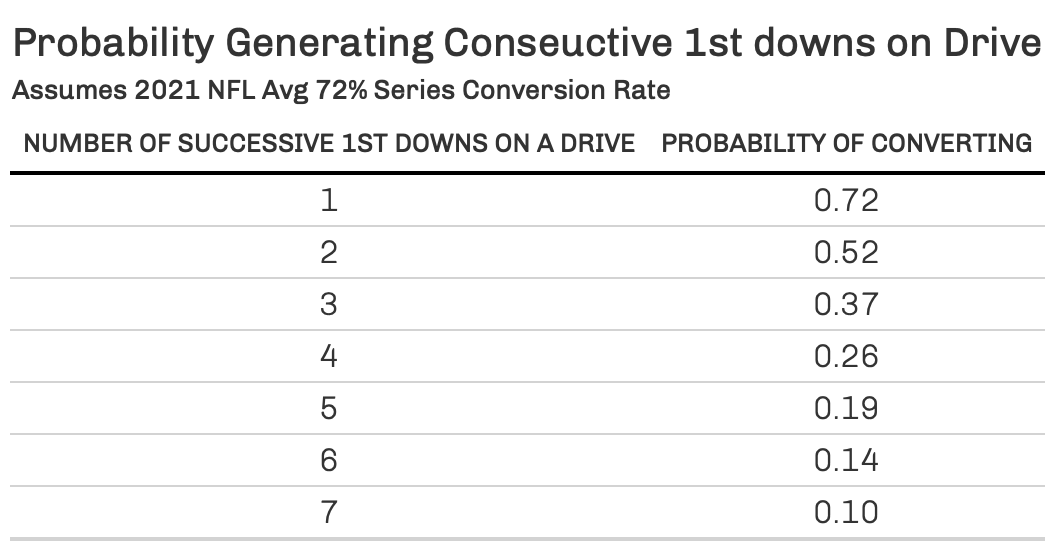
Certainly, a better series conversion rate is important to scoring, but a high series conversion rate is not enough. For consistent offensive success, teams also need to generate explosive plays, as explosive play success is imperative to scoring points in today’s NFL.
Let's establish some base rates for drives with and without explosive plays, which is defined as a gain of 20 or more yards.
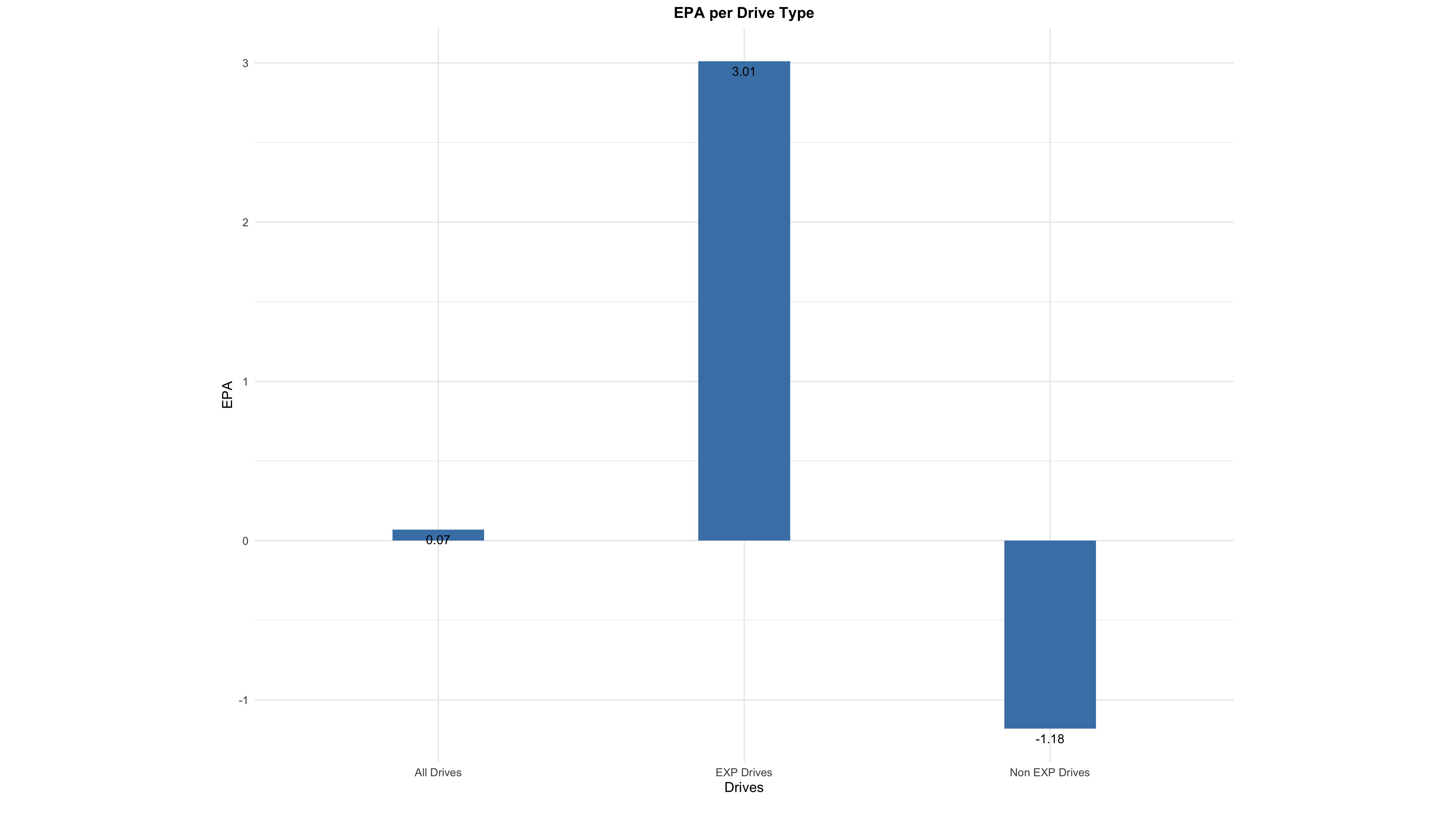
The difference in expected points is pretty stark. A drive's scoring expectation nearly quadruples from an explosive play, as expected points and actual points per drive in the 2021 season tell the same story.

The picture that emerges from the data is that to have success on a drive, just accumulating first downs won’t suffice, as offenses must generate explosive plays to optimize success. In addition, 20 yards is no magic number, but it helps exemplify the explosive approach's benefits over the marching approach.
Now, what about drives with multiple explosive plays?
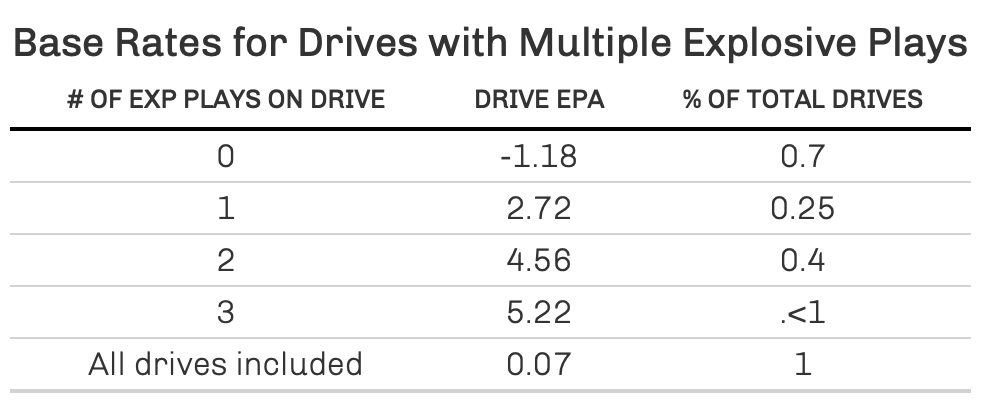
Of course, the more explosive plays on a drive, the higher the likelihood of scoring points. Nonetheless, additional explosive plays on a drive provide diminishing returns. This makes sense because the average drive has 2.2 expected points (see bar chart above), so there are only so many points to add considering one explosive play contributes to nearly five expected points on a given drive.
However, we should also note that while explosive plays are fairly uncommon, explosive drives account for nearly a third of all NFL drives. And if one explosive play raises the drive's scoring expectation immensely, we can begin to see that explosive plays, in terms of how they are connected to drives, are not rare one-off events but integral to drives and offensive success.
Run vs. Pass
Now that we have established the importance of explosive plays to drive success, let us explore some base rates for explosive plays on runs and passes.
Despite the run-pass ratio reflecting a 38% run to 62% pass split, explosive runs are only a small percentage (16.8%) of all explosive plays, as each run has only a minimal chance of becoming an explosive play (2.3%). So, in addition to their lower success rate, this drive success framework suggests that run plays are inferior to passing plays because they basically cede the chance for an explosive play. Running plays are the epitome of leaning into the less optimal “march down the field” drive strategy, as they only attempt to gain a few yards at a time. Moreover, there is no reason to suggest that run plays disproportionately set up the explosive pass, as the few plays immediately preceding explosive plays are in line with the overall run/pass rates.
So, while it is becoming clear that explosive plays are critical to offensive success, some argue they are random and hard to predict. However, at least for the passing game, using an extreme gradient boosting model (XGBoost) that combines game situation and PFF grades, we can begin to build the case to dispel that argument. And, at the same time, we can learn which factors are most important in influencing explosive pass plays.
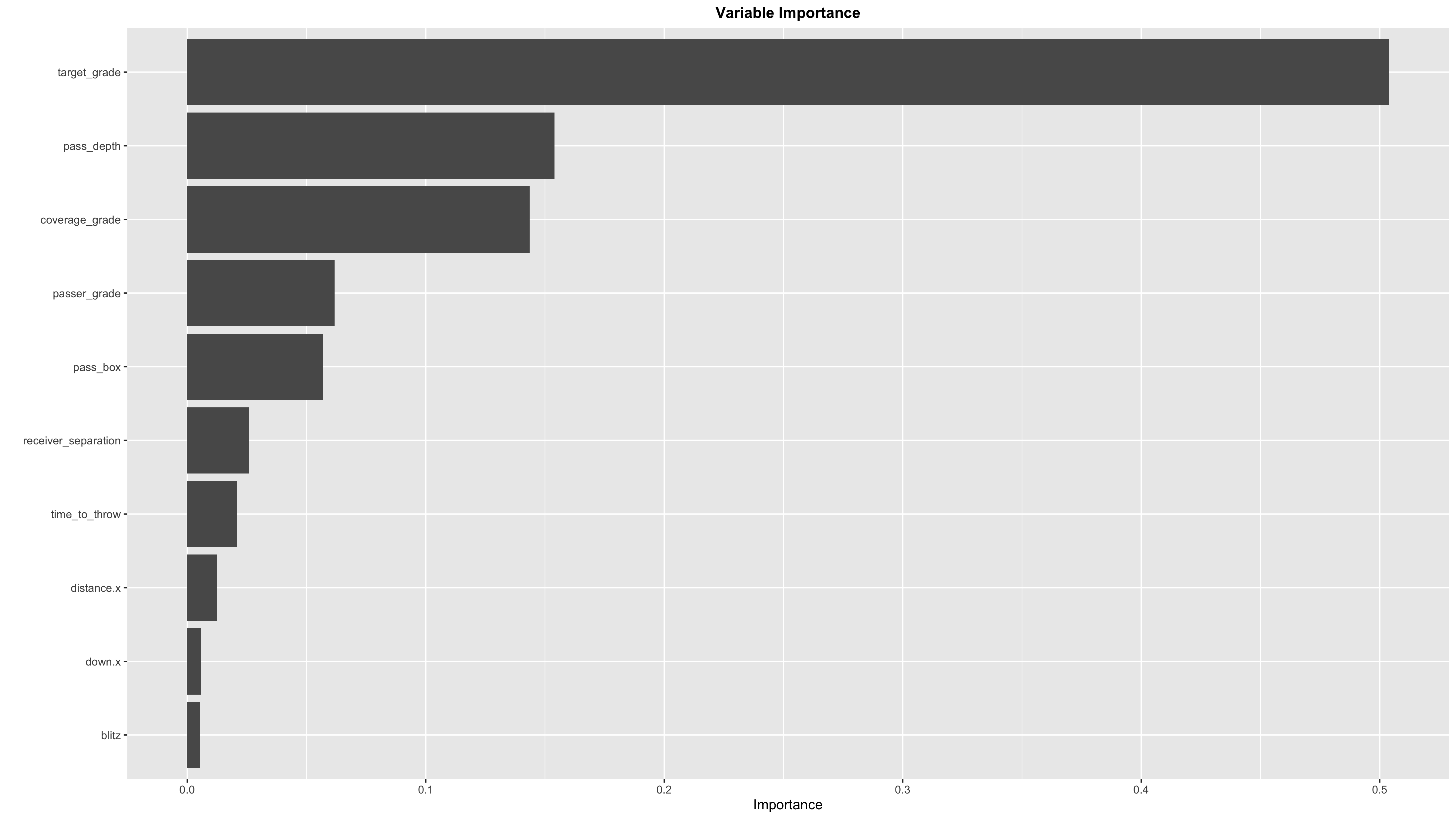
The model suggests that an elite target grade is, by far, the most important influence on explosive plays. Consider how often big plays are a product of a receiver winning downfield or breaking off a big run after the catch. Understanding the distribution of target grades, as seen below, provides further evidence of the importance of receiver play to explosive plays.
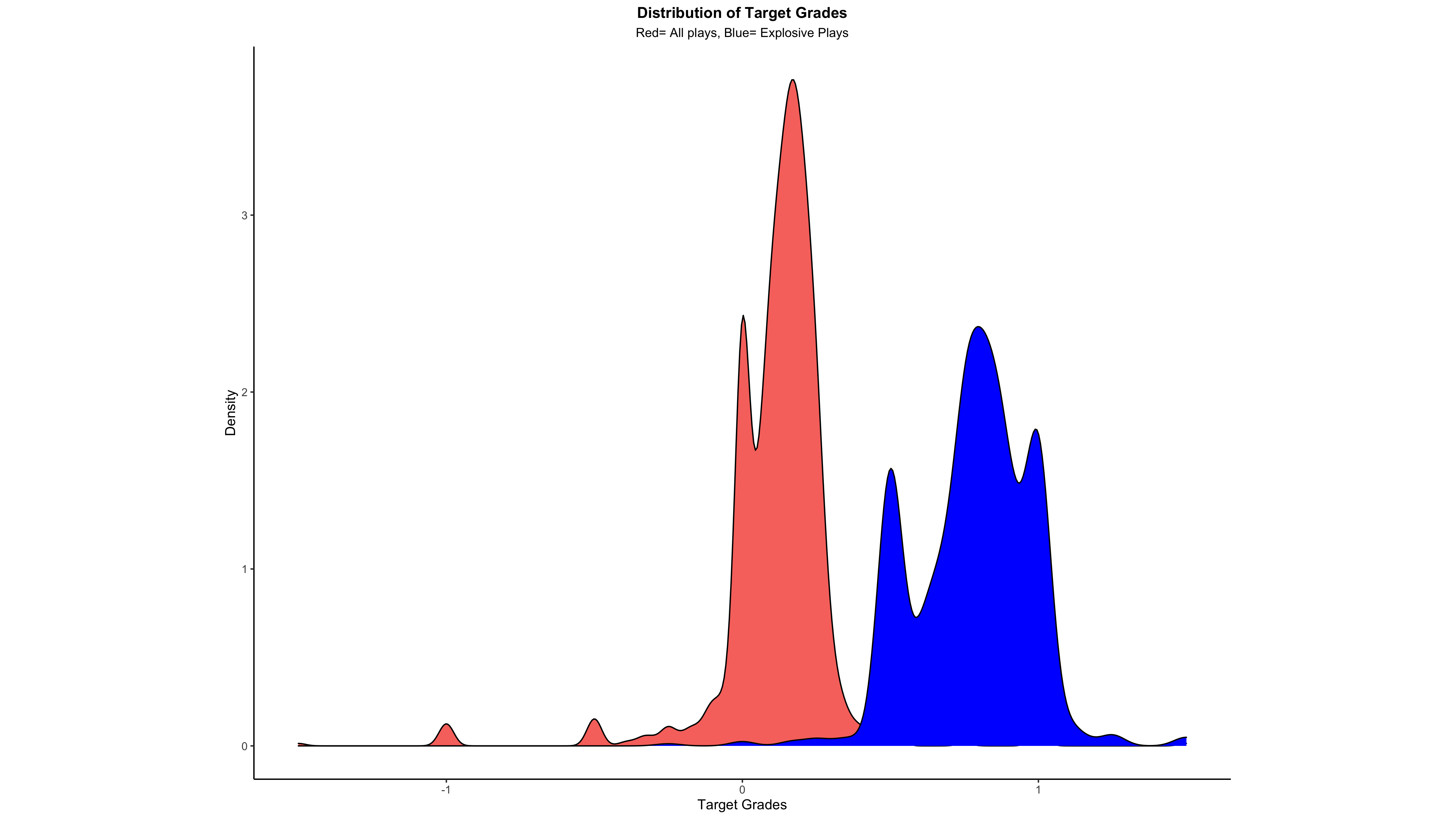
In PFF grading, each player is given a -2 to +2 grade in 0.5 increments on a given play and, as you can see in the red, most plays fall close to zero, which captures a receiver playing at “expectation.” However, on explosive plays — the blue — the distribution drastically shifts. When the targeted receiver produces an elite play, an explosive play often results, and without it, an explosive play is quite rare.
The other important predictors are rather intuitive. Pass depth captures how far a pass travels downfield. Next is coverage, which often determines whether a receiver is getting open or a defender is breaking up the potential explosive pass. And finally, defensive scheme — represented by men in the box — along with QB play factor into influencing an explosive play.
Aside from learning about the factors most influential to explosive success, this model — with 96% accuracy — predicts when an explosive play might occur. And this ROC curve — a receiver operating characteristic curve, which measures the performance of a classification model — tells a similar story.
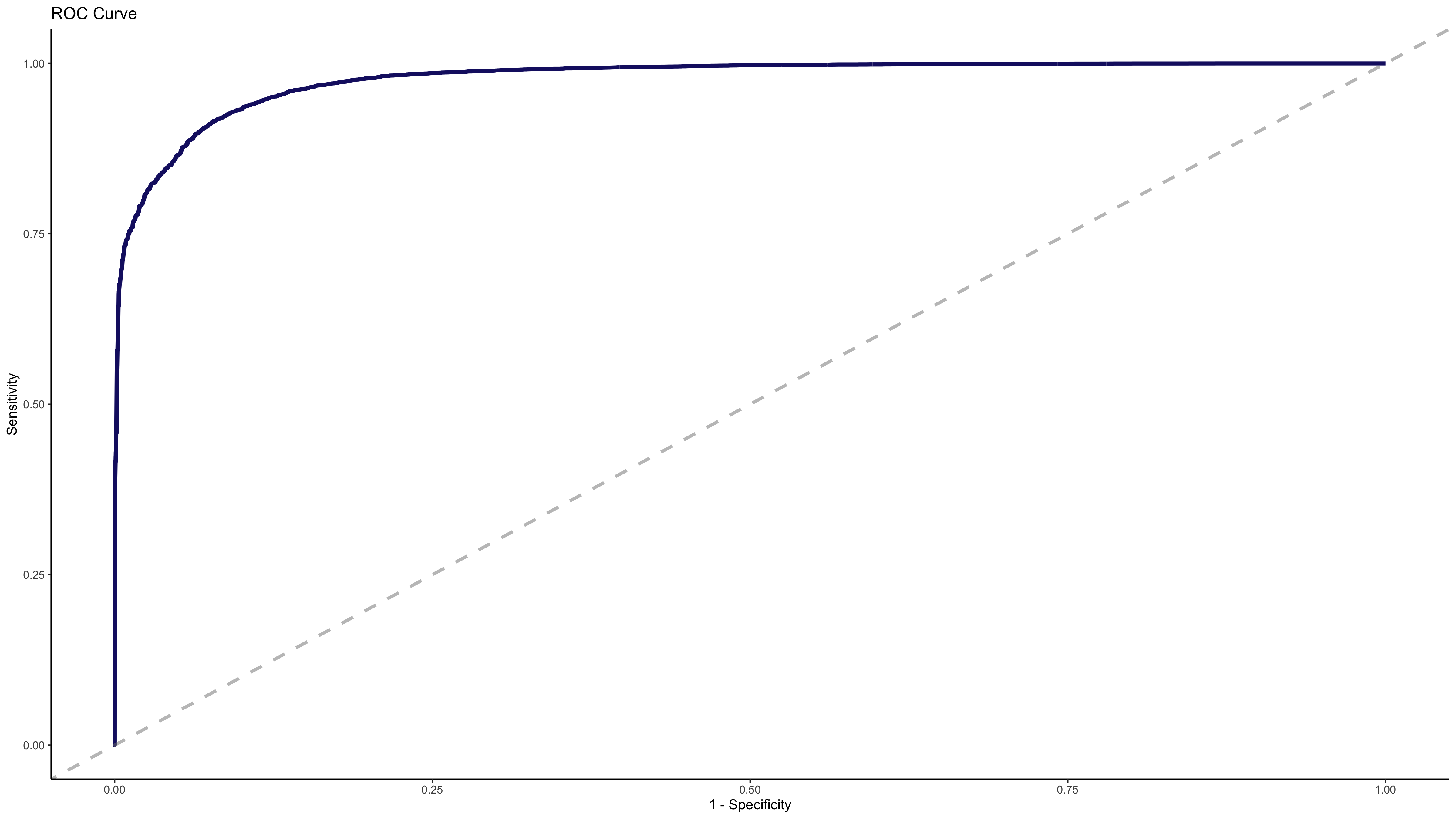
With the model tuned, we can now look to see which teams this past year were predicted for the most explosive plays.
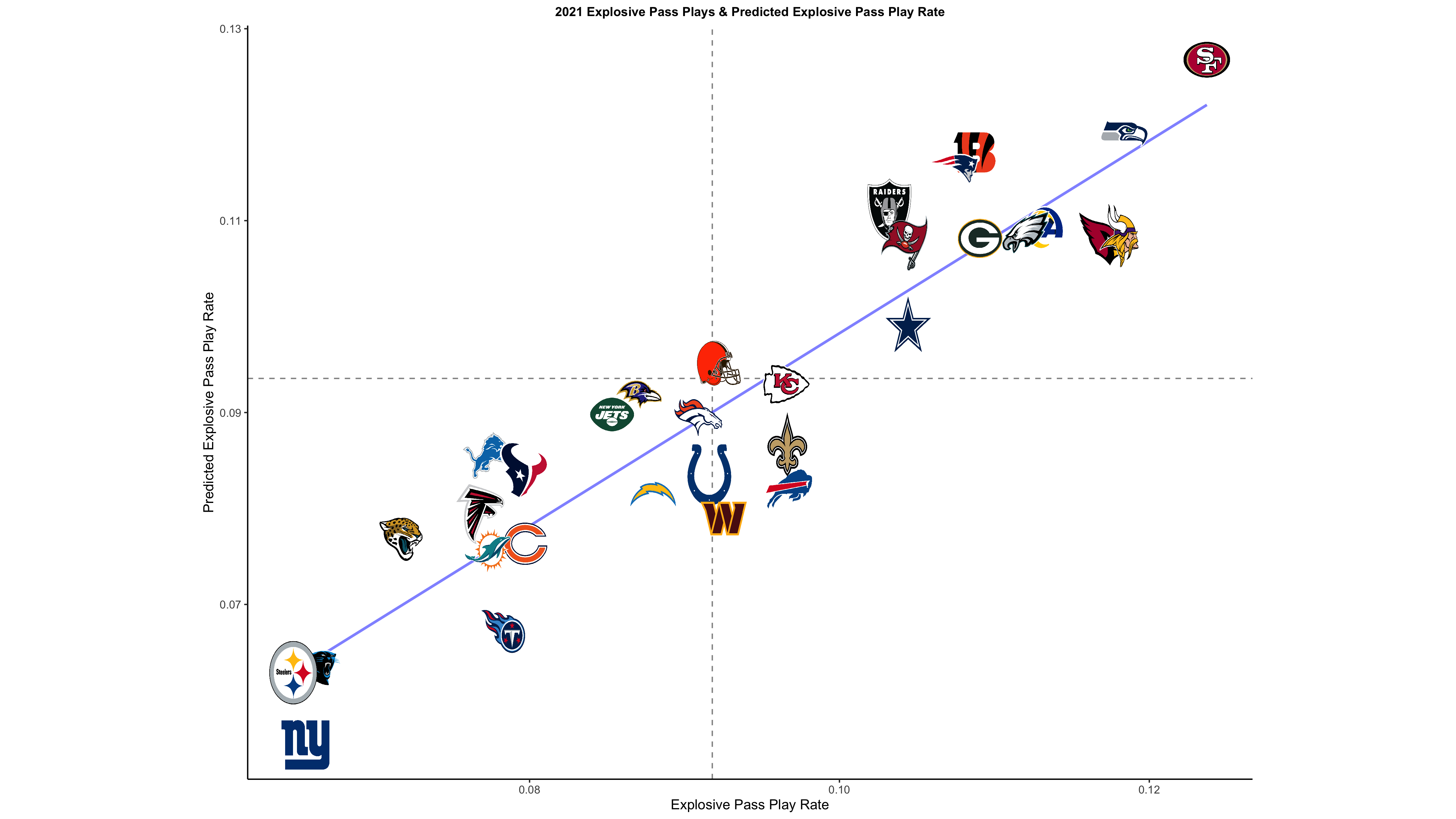
The San Francisco 49ers stand alone with the highest rate of both predicted and actual explosive play rate on passing plays. However, this does not tell the full story.
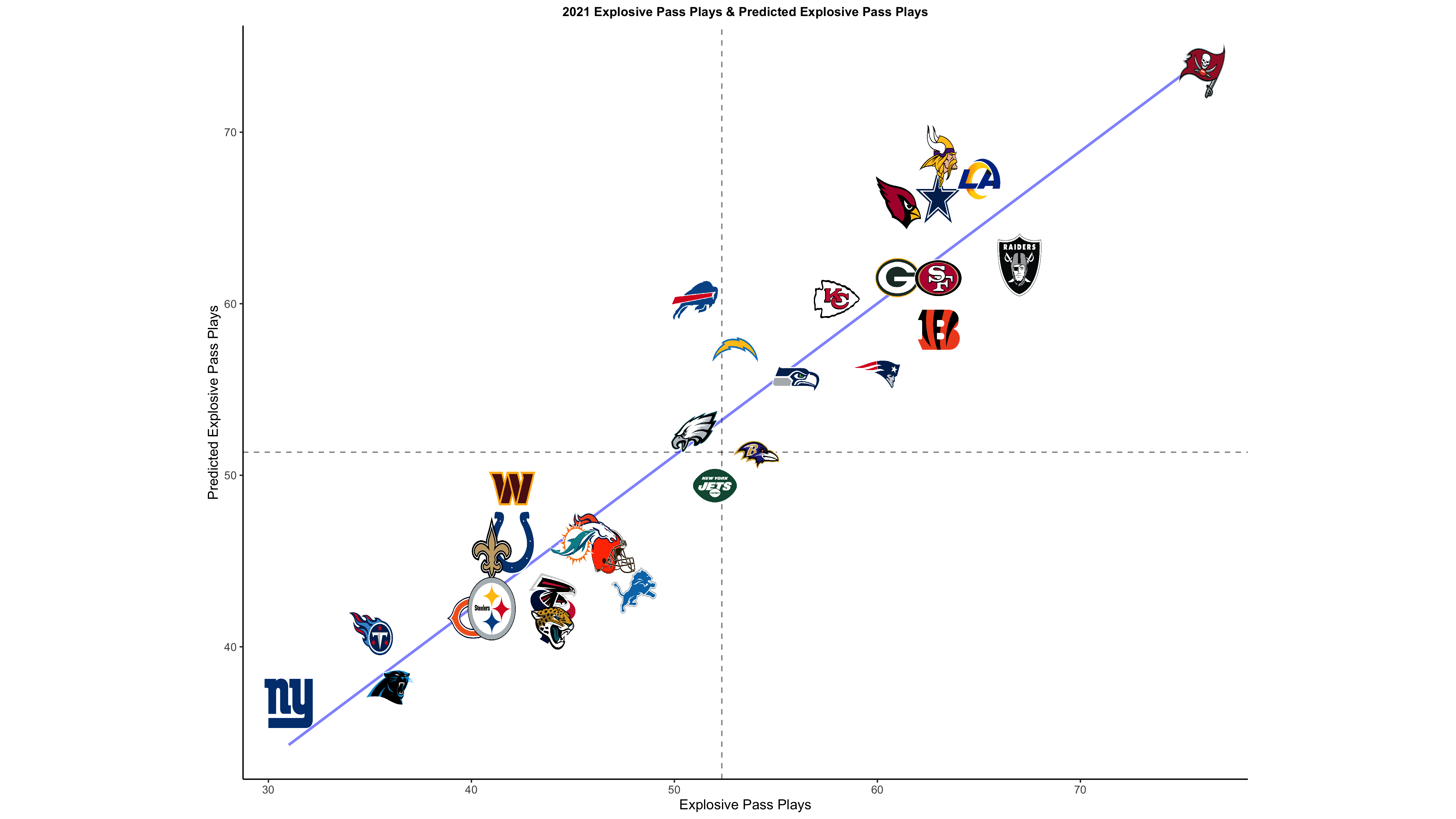
Using volume statistics paints a different picture, as it not only incorporates how efficient teams were on passing plays but folds in run-pass ratios and how often teams attempt explosive plays.
Consider teams such as the Philadelphia Eagles and 49ers, who were highly efficient when passing but did not generate as many explosive passing plays due to their high run rates. In addition, the Tampa Bay Buccaneers finished 11th in predicted explosive play rate but passed so often that their explosive play volume increased.
Volume matters and more explosive plays correspond to more drives ending in points.
This graph also allows us to get a sense of which teams enjoyed the most explosive success while also detecting teams that were a bit lucky (or unlucky) over the course of the season. The Buffalo Bills were the unluckiest team, posting nearly nine explosive plays below expectation. It's likely not a coincidence that Buffalo “underachieved” during the regular season. Not to mention, the Las Vegas Raiders — who many felt overachieved by earning a playoff berth — were the luckiest explosive team, generating nearly five explosive plays above expectation.
Explosive plays and explosive expectations are my preferred metrics. Explosive expectations are strong predictors of how well teams can design and maximize their offense to generate explosive plays and offensive success. In addition, they seem less prone to variance than one might have initially thought.
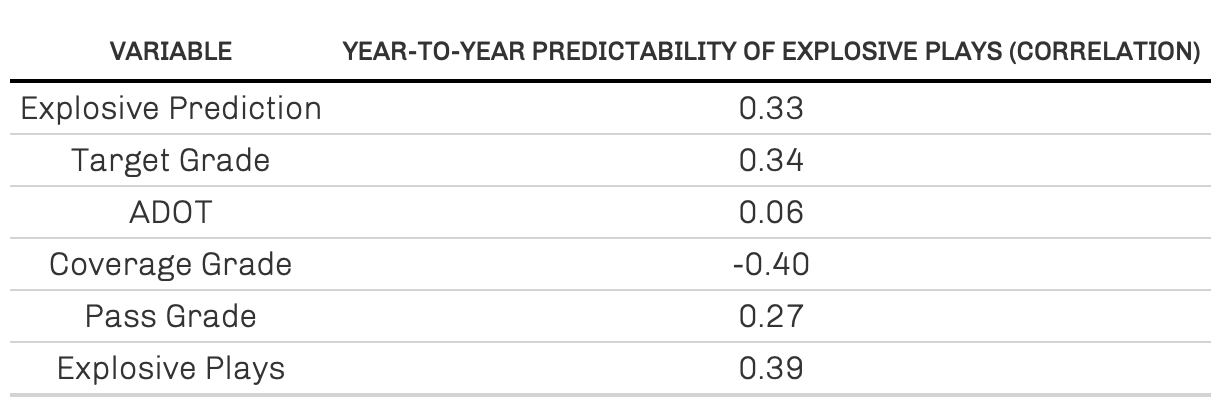
Explosive plays (.39) are about as stable year to year as common metrics such as EPA (.43). Considering the baked-in randomness to football and the general player/coach turnover each year, this is about as stable as football metrics will get.
Looking ahead to next year, this chart also helps us see which parts predict future explosive plays the best. Receiver play is again at the top of the list, as it can change the entire complexion of an otherwise similar offense, which was the case with Ja’Marr Chase in 2021 and Stefon Diggs in 2020. With so many high-end receivers on the free-agent market, this same phenomenon could repeat once again this year. For teams such as the Kansas City Chiefs, who generated high series success rates but struggled to generate explosive plays, adding an explosive receiver could help them return to the explosive offense that defined the Patrick Mahomes era's early dominance.
To bring it back together, explosive plays are absolutely essential to a drive's potential success, as a team’s expected points nearly quadruple on drives that have an explosive play. This suggests that the means to drive success is not generating first down after first down but rather, taking shots to generate chunk plays. Explosive plays are overwhelming accrued on passing plays that are driven by high-end receiver play and QB play in addition to the opponent's talent and scheme.
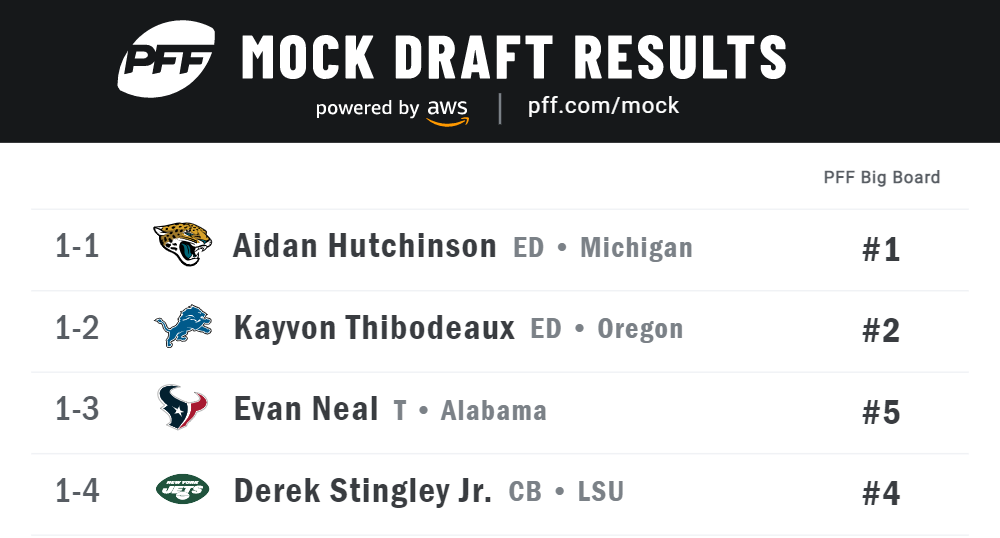
Further Applications
I’ve laid out only a rough sketch and argument for the importance of explosive plays. There is so much more research and analysis to be done on their relative importance to drive success and how that might change the way teams generally approach offense. Further areas of study can include incorporating the dynamic nature of explosive plays more, learning more about receivers' value to an offense, as well as quantifying explosive attempts, where tracking data would be a huge help. In addition, perhaps building a metric similar to on-base plus slugging plus (OPS+) by incorporating matchup, series success rate and explosive plays will be more predictive to evaluate NFL offenses.
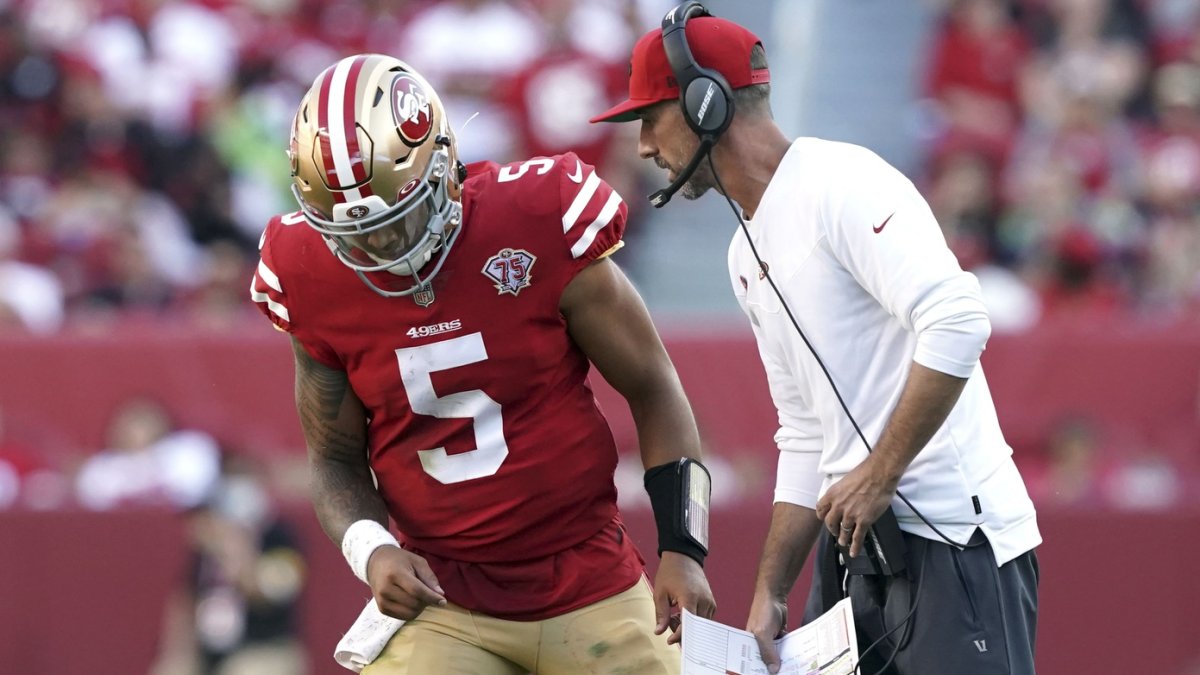




 © 2025 PFF - all rights reserved.
© 2025 PFF - all rights reserved.